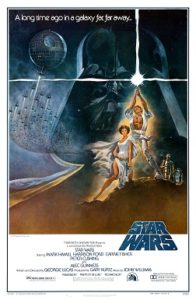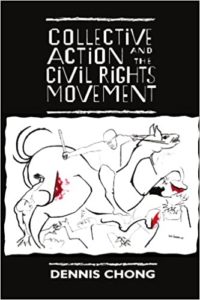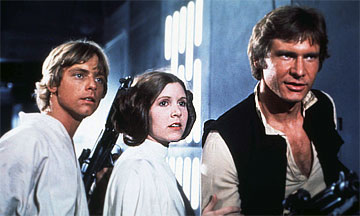In the original Star Wars film, later dubbed A New Hope, Luke Skywalker was initially reluctant to join the rebellion against the Empire. As he told Obi-Wan Kenobi, “Look, I can’t get involved. I’ve got work to do. It’s not that I like the Empire; I hate it, but there’s nothing I can do about it right now… It’s all such a long way from here.”

Luke notes that joining the rebellion would be costly. Joining the rebellion would mean failing to engage in work he has committed to do, work that helps his family. He perceives this cost as so high that he believes he “can’t get involved.”
In the real world, joining a revolutionary movement is costly too. Time and resources that someone puts towards a movement could have otherwise been used for other purposes. In addition to expending time and resources, participants may face violence from the state or rival factions. At the same time, these movements are often striving for political changes that are ultimately non-excludable. If a rebellion overthrows an unwanted government, those who stood on the sidelines are also freed from that unwanted government. This creates a collective action problem. There is an incentive to free ride on the efforts of others, rather than making the costly move of joining the fight.
And yet, despite these collective action problems, revolutions and other social movements do happen. How does this happen? Why don’t all the prospective revolutionaries choose to free ride, as The Logic of Collective Action leads us into the logic of collective inaction? Part of the answer is that rebels create selective incentives for people to participate in their movement. A selective incentive is an excludable good provided to those who contribute to the production or provision of a collective good.
While being free from a hated despot or empire is not easily excludable, plenty of other things are. For instance, a medal or some other form of accolade is excludable. So too are food and drinks offered at revolutionary gatherings. Camaraderie with and esteem from others who share your values is less tangible, but it’s still excludable and it’s still something people value. The strategies available to address collective action problems are diverse, and often these solutions will play mutually reinforcing roles. Mark Lichbach explores the diversity of these solutions in his book The Rebel’s Dilemma. Dennis Chong explores some of the ways civil rights activists addressed similar problems in his book Collective Action and the Civil Rights Movement.

This literature has had a big influence on my work with Chris Coyne on polycentric defense. The diversity of real-world social movements and rebellions shows that people can address collective action problems and defend themselves from both external invaders and their own domestic governments. Too many economists see free rider problems and tacitly presume that only some intervention like taxation or conscription can address it. But sometimes people address these problems from the bottom up.
Social dilemmas are real. Contributing to a collective goal is costly, and often it may be tempting to say “I can’t get involved.” Yet in Star Wars, and in our world, that’s just the start of the story. People are capable of devising strategies from the bottom-up that convince their fellows to join them in collective action.
Nathan P. Goodman is a Postdoctoral Fellow in the Department of Economics at New York University. His research interests include defense and peace economics, self-governance, public choice, institutional analysis, and Austrian economics.


READER COMMENTS
Allison
Jul 19 2022 at 12:59pm
Very interesting read!!! I really enjoy getting the broader perspective on what was a pretty zoomed in story, and the idea of polycentric defense is a fascinating one!
nobody.really
Jul 19 2022 at 5:21pm
[On the eve of the Battle of Agincourt]
WESTMORELAND: O that we now had here
But one ten thousand of those men in England
That do no work to-day!
KING HENRY V: What’s he that wishes so?
* * *
No, faith, my coz, wish not a man from England:
God’s peace! I would not lose so great an honour
As one man more, methinks, would share from me
For the best hope I have. O, do not wish one more!
* * *
This day is called the feast of Crispian:
He that outlives this day, and comes safe home,
Will stand a tip-toe when the day is named,
And rouse him at the name of Crispian.
He that shall live this day, and see old age,
Will yearly on the vigil feast his neighbours,
And say ‘To-morrow is Saint Crispian:’
Then will he strip his sleeve and show his scars.
And say ‘These wounds I had on Crispin’s day.’
Old men forget: yet all shall be forgot,
But he’ll remember with advantages
What feats he did that day: then shall our names.
Familiar in his mouth as household words
Harry the king, Bedford and Exeter,
Warwick and Talbot, Salisbury and Gloucester,
Be in their flowing cups freshly remember’d.
This story shall the good man teach his son;
And Crispin Crispian shall ne’er go by,
From this day to the ending of the world,
But we in it shall be remember’d;
We few, we happy few, we band of brothers;
For he to-day that sheds his blood with me
Shall be my brother; be he ne’er so vile,
This day shall gentle his condition:
And gentlemen in England now a-bed
Shall think themselves accursed they were not here,
And hold their manhoods cheap whiles any speaks
That fought with us upon Saint Crispin’s day.
King Henry V, from Shakespeare’s Henry V, Act IV, Scene III
Dylan
Jul 20 2022 at 7:15pm
The question doesn’t seem to be are rebellions possible even with the the free rider problem, as you say the existence of any rebellions proves they can happen. The question is, do we get the socially optimal number of successful rebellions with that problem? As a liberty loving individual, the number of despotic governments around the world biases me to say no, but I admit that is substituting my preferences for everyone.
Cyril Morong
Jul 21 2022 at 12:49pm
“a medal or some other form of accolade is excludable.”
Napoleon Bonaparte supposedly once said something like “I have made a wonderful discovery: Men Will Die For Ribbons”
Comments are closed.